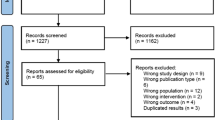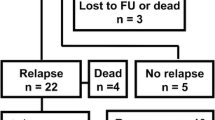Abstract
To explore the clinical characteristics and outcomes in Chinese patients with type I cryoglobulinemia (CG), we retrospectively analyzed the clinical data, management, and outcomes of 45 patients diagnosed with type I CG in our hospital from January 2015 to March 2019. In our study, all type I CGs were secondary to hematologic diseases, and monoclonal gammopathy of unknown significance was the most common primary disease, accounting for 48.9% (n = 22). Additionally, B cell non-Hodgkin lymphoma, Waldenström’s macroglobulinemia, and multiple myeloma accounted for 24.4% (n = 11), 20.0% (n = 9), and 6.7% (n = 3), respectively. In patients with type I CG, skin damage was the most common symptom, presenting in 57.8% of the patients, followed by peripheral neuropathy (22.2%) and renal involvement (15.6%). Treatment was initiated in 29 patients (64.4%), and the most common choice was a rituximab-based regimen in 13 patients (44.8%), followed by bortezomib-based regimen in 11 patients (37.9%). Clinical symptoms were significantly improved after treatment, and the clinical remission rate was 86.2%, including 34.5% of complete clinical remission, while the laboratory response rate was 88.9%, including 33.3% of complete response and 55.6% of partial response. The expected 1-year overall survival was 97.8%. In conclusion, for patients with multisystemic involvement, such as skin damage, kidney damage, or peripheral neuropathy, the diagnosis of type I CG should be considered, and the underlying disease needs to be explored. Symptoms and primary diseases should be taken into consideration before choosing initial management.


Similar content being viewed by others
References
Brouet JC, Clauvel JP, Danon F, Klein M, Seligmann M (1974) Biologic and clinical significance of cryoglobulins. A report of 86 cases. Am J Med 57(5):775–788. https://doi.org/10.1016/0002-9343(74)90852-3
Damoiseaux J, Cohen Tervaert JW (2014) Diagnostics and treatment of cryoglobulinaemia: it takes two to tango. Clin Rev Allergy Immunol 47(3):299–310. https://doi.org/10.1007/s12016-013-8390-y
Ramos-Casals M, Stone JH, Cid MC, Bosch X (2012) The cryoglobulinaemias. Lancet 379(9813):348–360. https://doi.org/10.1016/S0140-6736(11)60242-0
Terrier B, Cacoub P (2013) Cryoglobulinemia vasculitis: an update. Curr Opin Rheumatol 25(1):10–18. https://doi.org/10.1097/BOR.0b013e32835b15f7
Kolopp-Sarda MN, Miossec P (2018) Cryoglobulins: An update on detection, mechanisms and clinical contribution. Autoimmun Rev 17(5):457–464. https://doi.org/10.1016/j.autrev.2017.11.035
Desbois AC, Cacoub P, Saadoun D (2019) Cryoglobulinemia: An update in 2019. Joint Bone Spine 86(6):707–713. https://doi.org/10.1016/j.jbspin.2019.01.016
Motyckova G, Murali M (2011) Laboratory testing for cryoglobulins. Am J Hematol 86(6):500–502. https://doi.org/10.1002/ajh.22023
Damoiseaux J (2014) The diagnosis and classification of the cryoglobulinemic syndrome. Autoimmun Rev 13(4-5):359–362. https://doi.org/10.1016/j.autrev.2014.01.027
Rajkumar SV, Dimopoulos MA, Palumbo A, Blade J, Merlini G, Mateos MV, Kumar S, Hillengass J, Kastritis E, Richardson P, Landgren O, Paiva B, Dispenzieri A, Weiss B, LeLeu X, Zweegman S, Lonial S, Rosinol L, Zamagni E, Jagannath S, Sezer O, Kristinsson SY, Caers J, Usmani SZ, Lahuerta JJ, Johnsen HE, Beksac M, Cavo M, Goldschmidt H, Terpos E, Kyle RA, Anderson KC, Durie BG, Miguel JF (2014) International Myeloma Working Group updated criteria for the diagnosis of multiple myeloma. Lancet Oncol 15(12):e538–e548. https://doi.org/10.1016/S1470-2045(14)70442-5
Swerdlow SH, Campo E, Pileri SA, Harris NL, Stein H, Siebert R, Advani R, Ghielmini M, Salles GA, Zelenetz AD, Jaffe ES (2016) The 2016 revision of the World Health Organization classification of lymphoid neoplasms. Blood 127(20):2375–2390. https://doi.org/10.1182/blood-2016-01-643569
Terrier B, Karras A, Kahn JE, Le Guenno G, Marie I, Benarous L, Lacraz A, Diot E, Hermine O, de Saint-Martin L, Cathebras P, Leblond V, Modiano P, Leger JM, Mariette X, Senet P, Plaisier E, Saadoun D, Cacoub P (2013) The spectrum of type I cryoglobulinemia vasculitis: new insights based on 64 cases. Medicine (Baltimore) 92(2):61–68. https://doi.org/10.1097/MD.0b013e318288925c
Sidana S, Rajkumar SV, Dispenzieri A, Lacy MQ, Gertz MA, Buadi FK, Hayman SR, Dingli D, Kapoor P, Gonsalves WI, Go RS, Hwa YL, Leung N, Fonder AL, Hobbs MA, Zeldenrust SR, Russell SJ, Lust JA, Kyle RA, Kumar SK (2017) Clinical presentation and outcomes of patients with type 1 monoclonal cryoglobulinemia. Am J Hematol 92(7):668–673. https://doi.org/10.1002/ajh.24745
Cao XX, Tian Z, Lin L, Sun J, Su W, Zhou DB, Li J (2018) Successful treatment of type 1 cryoglobulinemic vasculitis with cardiac involvement. Can J Cardiol 34(3):343 e341–343 e343. https://doi.org/10.1016/j.cjca.2017.12.018
Harel S, Mohr M, Jahn I, Aucouturier F, Galicier L, Asli B, Malphettes M, Szalat R, Brouet JC, Lipsker D, Fermand JP (2015) Clinico-biological characteristics and treatment of type I monoclonal cryoglobulinaemia: a study of 64 cases. Br J Haematol 168(5):671–678. https://doi.org/10.1111/bjh.13196
Neel A, Perrin F, Decaux O, Dejoie T, Tessoulin B, Halliez M, Mahe B, Lamy T, Fakhouri F, Jego P, Agard C, Vigneau C, Guenet L, Grosbois B, Moreau P, Hamidou M (2014) Long-term outcome of monoclonal (type 1) cryoglobulinemia. Am J Hematol 89(2):156–161. https://doi.org/10.1002/ajh.23608
Muchtar E, Magen H, Gertz MA (2017) How I treat cryoglobulinemia. Blood 129(3):289–298. https://doi.org/10.1182/blood-2016-09-719773
Funding
This study is supported by the National Natural Science Foundation of China (Grant No. 81570195, for LJ), Beijing Natural Science Foundation (Grant No. 7182128, for LJ), the Capital Health Research and Development of Special Fund (No. 2018-2-4015, for LJ), the CAMS Innovation Fund for Medical Sciences (Grant No. 2016-12M-1-002, for LJ), and the National Key Research and Development Program of China (Grant No. 2016YFC0901503, for LJ).
Author information
Authors and Affiliations
Corresponding author
Ethics declarations
Conflict of interest
The authors declare that they have no conflict of interest.
Ethical approval
This study was performed in accordance with the ethical standard laid down in the 1964 Declaration of Helsinki and its later amendments.
Additional information
Publisher’s note
Springer Nature remains neutral with regard to jurisdictional claims in published maps and institutional affiliations.
Rights and permissions
About this article
Cite this article
Zhang, Ll., Cao, Xx., Shen, Kn. et al. Clinical characteristics and treatment outcome of type I cryoglobulinemia in Chinese patients: a single-center study of 45 patients. Ann Hematol 99, 1735–1740 (2020). https://doi.org/10.1007/s00277-020-04123-1
Received:
Accepted:
Published:
Issue Date:
DOI: https://doi.org/10.1007/s00277-020-04123-1




